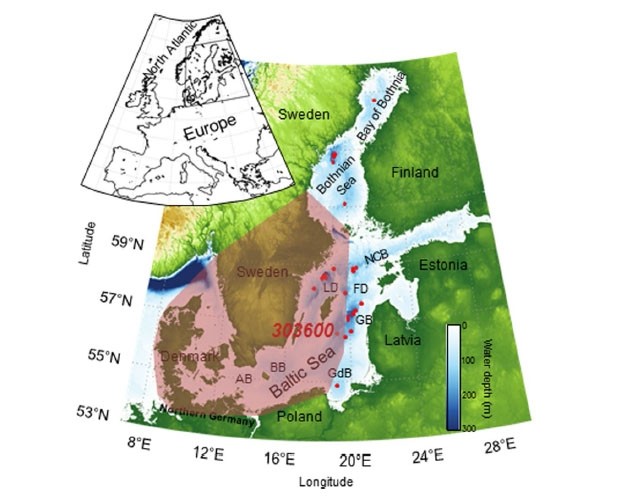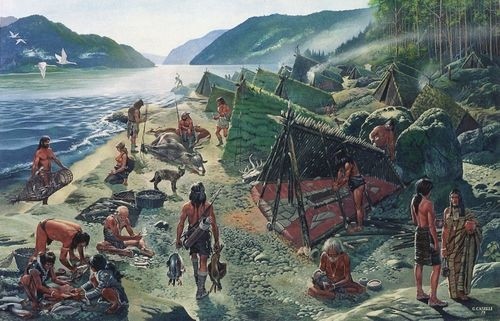Warming of Northern Europe triggered onset of farming
Rapid warming of the climate in Northern Europe led to a sharp population growth 6000 years ago and triggered the onset of farming in the Baltic Sea region. That is the main conclusion of a new, multidisciplinary study by an international team of geologists, geochemists, archaeologists, fishery biologists and ecosystem modellers who studied the temperature development during the Holocene in the Baltic region. The article, published in the science journal Scientific Reports, explains how rapid climate change is the main cause of the late transition in the Baltic region from hunter-gatherer-fishing-groups to farming society .
The exact trigger for the onset of farming in the Baltic region has remained long unclear for scientists. Geochemical research of NIOZ (Royal Netherlands Institute for Sea Research) resulted in a new seawater-temperature curve of the Holocene period. It is for the first time that the biomarker TEX86, acting as a proxy for sea surface temperature, was applied on a sediment core from the central Baltic Sea covering the time span from 7.100 – 3.000 years before present (BP) in high resolution. It reveals a fascinating temperature history, which provides an explanation why the transition from hunter-gatherer-fishing-groups to farming society (the Neolithic revolution) reached the Baltic area as late as 1.500 years after it appeared in the neighbouring areas in the South.

Water temperatures of the past
“The TEX86 biomarker serves as a kind of paleothermometer,” explains Lisa Warden, a former PhD-student at NIOZ. “It is based on the remains of certain microorganisms, so-called Thaumarchaeota. The composition of their membrane lipids change according to sea temperature. When the Thaumarchaeota die and sink to the seafloor, this information gets archived and can be retrieved by chemical analysis of these fossils.” During the investigated time span, these analyses showed a temperature range from 14.5 to 17.5 °C in the sea surface in summer. The TEX86 record detects a prolonged unstable but generally colder phase from 7.000 to 6.000 BP, followed by a distinct and rapid warming, which culminates in two temperature maxima at 5.600 and 4.500 years BP. Thus, in the Baltic Sea region the “Holocene Thermal Optimum” lasted only from 5.900 to 4.400 years BP.”
Demographic response
“Comparing these results with archaeological findings shows a striking parallel development.” Stephen Shennan, archaeologist at the University College London, has analysed the population development during the respective period. “From shortly after 6.000 years BP on we recognize a sharp increase in the population density parallel to the warming phase. We also see by the archaeological evidence that this goes with the onset of farming in the western Baltic Sea region. „With the significant increase in temperature, the scene was set for successful farming and an expansion of agrarian groups from the South. “Our study suggests a rapid human reaction within only two to three generations to these new opportunities emphasizing the remarkable plasticity humans can demonstrate in response to climate change,” resumes Shennan.

The backbone of the analyses was the recovery and dating of high resolution sediment cores. “We have developed a multi-proxy approach in order to drag as much information from the sediment cores as possible.” Matthias Moros, geologist at the Leibniz-Institute for Baltic Sea Research (IOW) coordinated all analyses related to the sediment archives. Together with NESSC-researcher Jaap Sinninghe Damsté, a biogeochemist at NIOZ and professor at Utrecht University, he designed the scientific approach of this study. “We knew already from the sediments that there was a distinct shift around 6.000 years BP: the sediment structure changed completely from homogenous to laminated. This is clear evidence for a change in the oxygen conditions at the sea floor. We know now, that this was triggered by the temperature rise.”
Effect on fish stocks
His colleague, IOW ecosystem modeller Thomas Neumann, showed that this was not a local, but a regional phenomenon influencing the Baltic as a whole. He concludes: “Our model provides a causal mechanism between temperature change and environmental conditions as reflected in the sedimentary record. We also speculated that the spread of anoxia must have affected the fish stocks in the Baltic at that time and that this must have been a trigger for the observed cultural changes.”
Sinninghe Damsté adds: “However, the archaeological data were not strong enough to claim this. Even so, this study clearly reveals the strength of multidisciplinary studies to understand human history”.
Article:
‘Climate induced human demographic and cultural change in northern Europe during the mid-Holocene’
Scientific Reports 7, 2017
Warden, L., Moros, M., Neumann, T., Shennan, S., Timpson, A., Manning, K., Sollai, M., Wacker, L., Perner, K., Häusler, K., Leipe, T., Zillén, L., Kotilainen, H., Jansen, E., Schneider, R.R., Oeberst, R., Arz, H. & Sinninghe Damsté, J.S.

